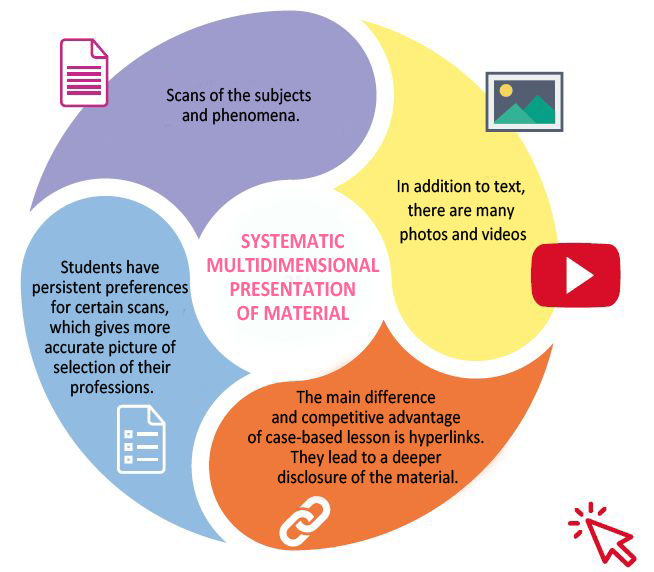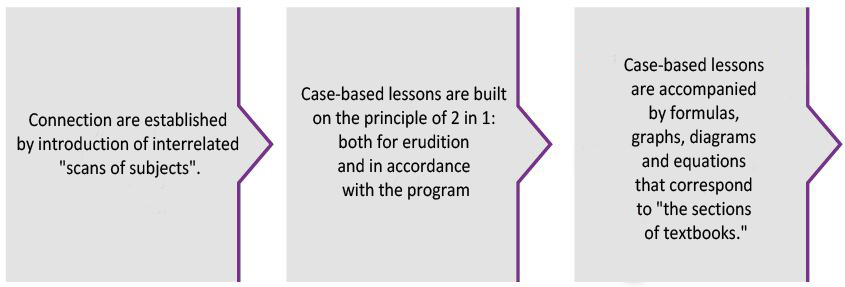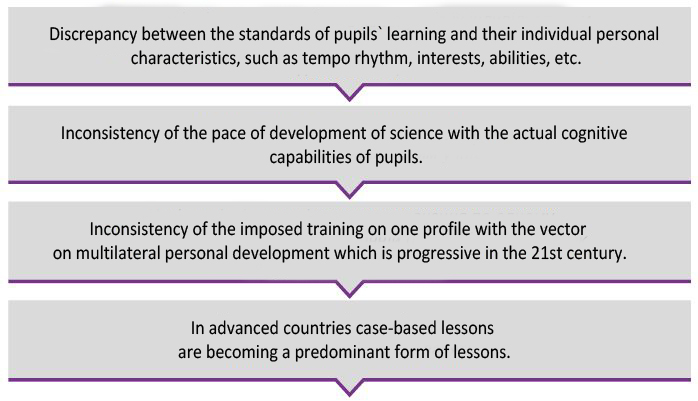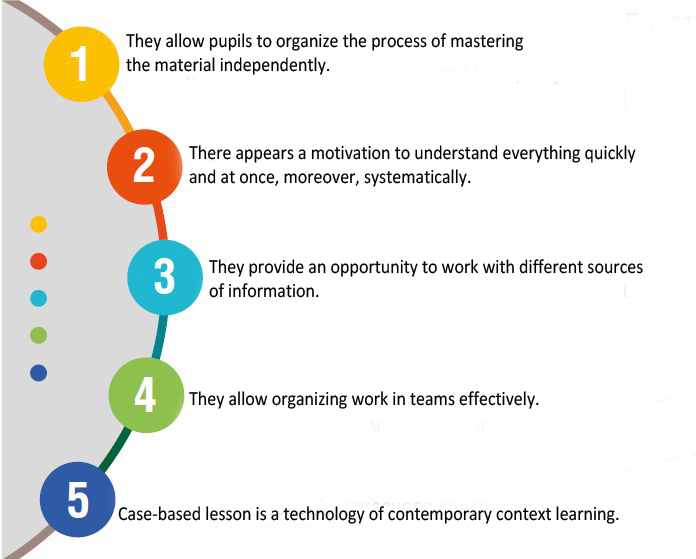What are case-based lessons?
Case-based lessons present training material structured in a special format. It consists of 6 or 10 scans that systematically display sections of the school curriculum, as well as related information beyond the school curriculum.
• Information in each section is not just abstracts, but answers to questions:
• How does it work?
• What problems are there?
• How can they be overcome?
• What can be the result?
• What is the fundamental and new knowledge in this field?
• Mini-stories.
Case-based lesson – this is not a summary or abstract, but an educational technology created by a special algorithm which gives a coherent idea of the phenomenon under study.
Why are case-based lessons effective?
The "subject" system existing now is largely obsolete, since it resembles the principle of separate nutrition, in which, as you know, proteins, fats, carbohydrates and vitamins are consumed separately.
However, human physiology is such that the digestive system digests mixed food much more efficiently than when it is divided into components. It is true about the food for the mind too.

The human brain absorbs information more actively and more efficiently, if the information is interrelated, and, on the contrary, homogeneous information is memorized by the brain worse, because it does not know where to "send it to storage."
Connection between academic disciplines and phenomena are easily established by introduction of interrelated " scans of subjects".
Case-based lessons are built on the principle of 2 in 1: both for erudition and in accordance with the program. They are accompanied by formulas, graphs, diagrams and equations that correspond to "the sections of textbooks."

One of the main benefits is that case-based lessons are a thread to adult life with a multidimensional perception of the world, values and phenomena.

What is the relevance of case-based lessons caused by?

Why are case-based lessons useful?

Case-based method is a technology of systematic multidimensional presentation of material in scans for several topics related to each other by accents of attention.
Case-based lessons allow simultaneously with learning topics organically interlace the soft skills of pupils, such as critical thinking, communication skills, wit, consistency, time management. This is a creative method with some intrigue, dramatic scenario and an opportunity to make choices, which cannot be achieved by ordinary lessons.
Discussions that arise in the classroom are particularly valuable.
During case-based lesson, time flies imperceptibly, which positively affects pupils' motivation and their desire to study other case-based lessons as well. It is also important that the result of information digestion is laid in the long-term memory. This happens thanks to associative thinking and formal-informal connections between case-based lessons cans.
Case-based lessons are opened with the help of scans for objects and phenomena. For example, case-based lesson "Smartphone" unfolds on the following vectors: physics-chemistry-business-mathematics-psychology-art. Case-based lessons "Sea" unfolds on the following vectors: ecology-geography-physics-art-economics-chemistry.
The presentation of the material suggests the optimal (and patented) proportion of presentation stylistics: 30% is devoted to scientific foundation of knowledge, 50% to the popular science explanation and 20% to generation of new ideas and thoughts by pupils. With this approach multifaceted learning of the material along with the development of critical and positive thinking is ensured.
Links
In case-based lessons, in addition to text, there are many photos and videos. However, the main difference and competitive advantage of case-based lessons is hyperlinks. They lead to a deeper disclosure of the material, which also has its own hyperlinks to third-fourth-fifth levels. Thus, each pupil is provided with an individual depth of penetration into "knowledge".
For example, in case-based lesson "The bus is running" in section "Physics" there is a link with the topic of physics "Straight-line motion, speed, acceleration" with formulas, graphs and tables of the section.
In section "Chemistry" there is the study of petroleum products, with corresponding chemical formulas, schedules and schemes. In section "Geography" there are directions, maps of the area, etc. In section "Business" there is a calculation of the cost of manufacturing a bus or the cost of a ticket.
For the personal growth of pupils it is supposed to apply augmented reality, clip thinking, critical and positive thinking.
When case-based lessons are applied many times, pupils have persistent preferences for certain scans and depths of knowledge comprehension, which gives teachers and parents a more accurate picture of their propensity for future selection of their professions, because this happens not obtrusively, but naturally.
Preparatory stage

Pupils may partially get prepared for the case-based lesson at home basing on the flipped classroom model, so as not to lose time for "boosting" in the classroom.
Realization of a case-based lesson
All scans "spin" around the main topic of the case-based lesson, and it is important not to lose this "red thread". The themes are intertwined and smoothly move from one scan to another. It is made on purpose to involve logical thinking, artistic images, mnemo and unexpected turnings of scenarios.
One of the goals is to train "to formulate questions", not just to look for answers to them.
Simultaneously with the development of pupils` cognitive activity in the process of case-based lesson discussion, the teacher can solve a number of other tasks, for example:
• To create a creative atmosphere in the classroom that promotes brainstorming and ability to defend own views.
• Evaluate pupils' knowledge and their points of view on various issues.
• Motivate pupils to work in a group.
• Stimulate mental and "psychical" work of pupils and maintain enthusiasm, even if the discussion goes into a dead end.
• Analyze pupils' performance of tasks and exercises with an emphasis on “what result they got”.
• Check the material learned by the pupils in practice.
• To form pupil`s creative attitude to the researched material and skills of induction and deduction (from partial to general and from general to specific).
Case-based lessons are especially convenient within the variable component of the program, for distance learning and expansion of school curriculum subjects.
Thus, the context of a case-based lesson is multifaceted: educational, emotional, psychological, scientific and personal. Discussion of conclusions
This stage is considered to be final. During this stage the teacher discusses with the pupils their individual and team achievements, as well as possible scenarios and concentration of the participants` attention on top priorities.
For each case-based lesson it is desirable to predict own version of its completion for motivation, so that its expectation will also be an element of the case-based lesson.
You can use the following options as a completion:
• Allow the pupils to make conclusions themselves. It is useful for their skills of public speaking.
• Suggest them to formulate questions that would be desirable to discuss if there was a continuation of the case-based lesson.
• Ask someone to share case-based lessons from their own lives regarding the topic of the case-based lesson.
Conclusion
Case-based lessons repeatedly increase effectiveness of educational process, as they allow to model the future adult life of pupils and form their positive motivation to master the material and receive new information and teach them the models "how to learn to study on your own" further.
Авторські права | Privacy Policy |FAQ | Партнери | Контакти | Кейс-уроки
© Автор системы образования 7W и Гипермаркета Знаний - Владимир Спиваковский
При использовании материалов ресурса
ссылка на edufuture.biz обязательна (для интернет ресурсов -
гиперссылка).
edufuture.biz 2008-© Все права защищены.
Сайт edufuture.biz является порталом, в котором не предусмотрены темы политики, наркомании, алкоголизма, курения и других "взрослых" тем.
Ждем Ваши замечания и предложения на email: 
По вопросам рекламы и спонсорства пишите на email: 








